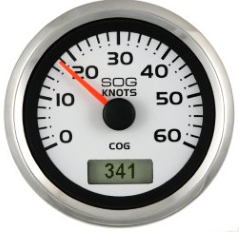GPS Speedometer: Difference between revisions
| (2 intermediate revisions by the same user not shown) | |||
| Line 10: | Line 10: | ||
::*Ideal for low-speed or high-speed watercraft or ground vehicles where traditional speed measuring devices do not work well | ::*Ideal for low-speed or high-speed watercraft or ground vehicles where traditional speed measuring devices do not work well | ||
::*Custom styles and speed ranges available | ::*Custom styles and speed ranges available | ||
===GPS Speedometer Antenna Placement=== | ===GPS Speedometer Antenna Placement=== | ||
| Line 19: | Line 16: | ||
===GPS Antenna Messaging=== | ===GPS Antenna Messaging=== | ||
The receivers output the messages as per the NMEA 0183 requirements. The low speed receiver outputs the $GPGGA, $GPRMC | The receivers output the messages as per the NMEA 0183 requirements. The low-speed receiver outputs the $GPGGA, $GPRMC and $GPGSA messages at 1Hz (every second), and the $GPGSV messages at 0.2 Hz (every 5 seconds). The high-speed receiver outputs the $GPGGA, $GPRMC and $GPGSA messages at 10Hz, and the $GPGSV messages at 2Hz. For more details, you can reference the NMEA 0183 specification itself. | ||
===Downloads=== | ===Downloads=== | ||
Latest revision as of 21:16, 24 January 2023
GPS Speedometer
The GPS Speedometer is an instrument designed to provide accurate ground referenced speed and headings all within an attractive package. It is available in various speed ranges and color schemes to fit your particular application. The GPS Speedometer can be connected to an existing NMEA0183 receiver, or you can purchase one specifically for use with it. The GPS technology in use makes this an appropriate product for any ground vehicle application, as well as low- and high-speed watercraft where in-water speed pickups like pitot tubes and paddle wheels do not work well.

- Features include:
- Available in speed ranges of 35 MPH, 60 MPH, 120 MPH, and 30 and 60 knots for marine applications
- Included LCD heading display to show heading
- Use our GPS receiver or any NMEA0183 receiver (NMEA2000 support coming soon)
- Speed accuracy of +/- 1 MPH once moving
- Heading accuracy of +/- 1 degree once moving
- Ideal for low-speed or high-speed watercraft or ground vehicles where traditional speed measuring devices do not work well
- Custom styles and speed ranges available
GPS Speedometer Antenna Placement
There are no hard and fast rules for placement of the GPS antenna, but it's generally recommended that it be able to see the sky and be placed on the outside of the vehicle. Enclosed locations often work fine, but are not guaranteed to. If you desire to place it in an enclosed location, test it first for sufficient signal strength.
GPS Antenna Messaging
The receivers output the messages as per the NMEA 0183 requirements. The low-speed receiver outputs the $GPGGA, $GPRMC and $GPGSA messages at 1Hz (every second), and the $GPGSV messages at 0.2 Hz (every 5 seconds). The high-speed receiver outputs the $GPGGA, $GPRMC and $GPGSA messages at 10Hz, and the $GPGSV messages at 2Hz. For more details, you can reference the NMEA 0183 specification itself.